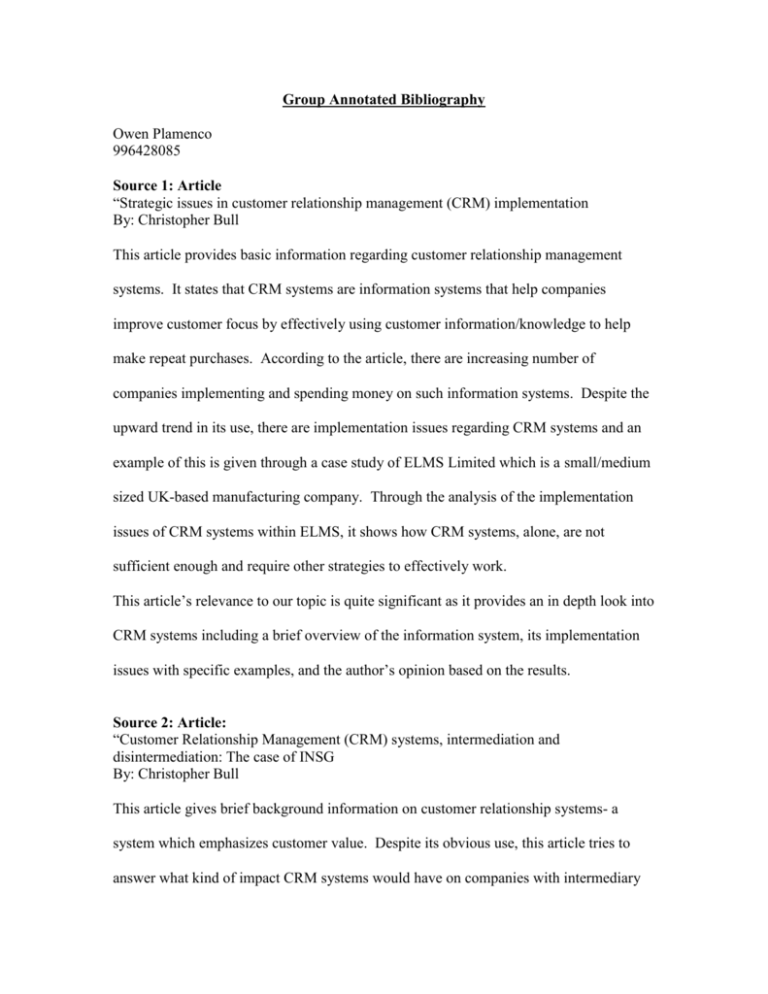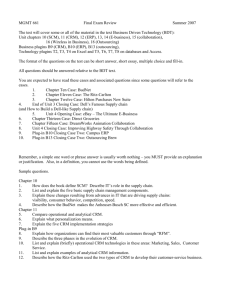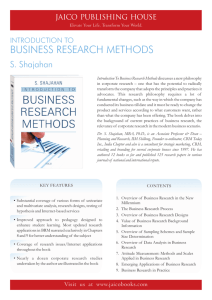Group Annotated Bibliography
advertisement

Group Annotated Bibliography Owen Plamenco 996428085 Source 1: Article “Strategic issues in customer relationship management (CRM) implementation By: Christopher Bull This article provides basic information regarding customer relationship management systems. It states that CRM systems are information systems that help companies improve customer focus by effectively using customer information/knowledge to help make repeat purchases. According to the article, there are increasing number of companies implementing and spending money on such information systems. Despite the upward trend in its use, there are implementation issues regarding CRM systems and an example of this is given through a case study of ELMS Limited which is a small/medium sized UK-based manufacturing company. Through the analysis of the implementation issues of CRM systems within ELMS, it shows how CRM systems, alone, are not sufficient enough and require other strategies to effectively work. This article’s relevance to our topic is quite significant as it provides an in depth look into CRM systems including a brief overview of the information system, its implementation issues with specific examples, and the author’s opinion based on the results. Source 2: Article: “Customer Relationship Management (CRM) systems, intermediation and disintermediation: The case of INSG By: Christopher Bull This article gives brief background information on customer relationship systems- a system which emphasizes customer value. Despite its obvious use, this article tries to answer what kind of impact CRM systems would have on companies with intermediary relationships with other companies. Included in the article is a case study which depicts an international company known as INSG which provides insurance services and how they designed and utilized their own CRM information system with regards to their numerous intermediaries. Through their CRM system, INSG discovered several strategies they can apply to improve performance and customer value. First, eliminate weaker intermediaries, second evaluate the performance of their intermediaries & take notice of the results, and acquire those that had a positive impact on the company. A well designed CRM system can improve customer service through uses of intermediaries like that if INSG. The relevance of this article, with regards to our topic, is very much significant as it addresses another aspect of CRM systems and is shown through specific examples including real companies that have experiences within the topic. Source 3: Article “Making customer relationship management work: evidence from the banking industry in Taiwan” By: Nan-Hong Lin, Wen-Chen Tseng, Yu-Chung Hung, David C. Yen This article states the key to success in most companies is retaining its customers by improving, developing, and maintaining customer relationships through effective customer relationship management information systems. This is due to the fact that customer value is directly correlated to customer relationship management. The article uses a specific example of the banking industry in Taiwan to portray the relationships between CRM systems and customer value. In addition, it shows the different subrelationships within them (ie. customer loyalty, customer behavior, and customer satisfaction) and ultimately how one can make CRM work. It does so through an RFM model (recency, frequency, and monetary) which records customers’ past purchases, determining the relationship outcomes through various customer attributes, questionnaires, data collection/research, and through structural equation modeling (SEM) which measures the relationship between the data and research. This article is highly relevant to that of our topic for the fact that the whole article gives clear detailed descriptions of important concepts and an in depth analyses between relationships related to CRM. Also, the article includes models which are good analytical tools in organizing and visualizing data. Source 4: Book “Customer Relationship Management Systems Handbook” By: Duane E. Sharp This book is solely based on the different aspects regarding customer relationship management systems. It is a text that goes in depth into the topic and consists of 6 parts/chapters each covering different sections. Chapters 1 & 2, describes how customers have evolved, what characteristics must be taken into consideration to effectively enhance the relationships among companies’ customers, how CRM systems are interconnected with customer relations, and how the two contribute to increased performance within a company. Followed is chapter 3 which goes into specific details about the technology of CRM systems which is followed by specific examples via case studies. Finally, the last chapters of the text are focused on the pros and cons of such an information system (ie. privacy issues, overall benefits within different sectors of business, etc). The relevance of this book to our topic is self explanatory. This book was specifically written to educate people about CRM systems. It contains essential information, specific examples, and figures/graphics which allow people to visually understand different concepts. References 1. Bull, Christopher. "Strategic issues in customer relationship management (CRM) implementation." Business Process Management Journal 9.5 (2003): 592-602. Emerald Insight. Web. 10 Mar. 2010. 2. Bull, Christopher . "Customer Relationship Management (CRM) systems, intermediation and disintermediation: The case of INSG ." International Journal Information Management 30.1 (2010): 94-97. Scholars Portal. Web. 10 Mar. 2010. 3. Lin, Nan-Hong, Wen-Chun Tseng, Yu-Chung Hung, and David C. Yen. "Making customer relationship management work: evidence from the banking industry in Taiwan." The Service Industries Journal 29.9 (2009): 1183-1197. Informaworld. Web. 11 Mar. 2010. 4. Sharp, Duane. Customer Relationship Management Systems Handbook. N/A: Auerbach Publication, 2003. Print.








